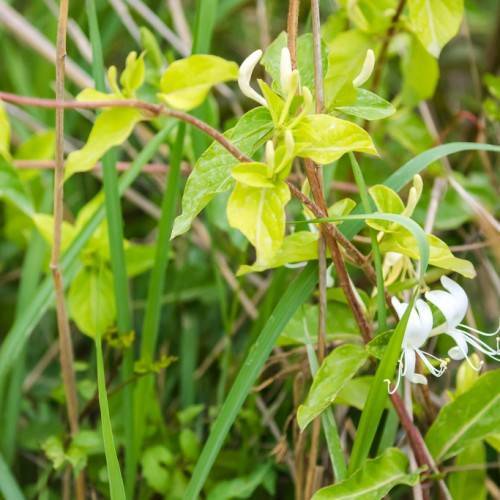
Japanese honeysuckle
Lonicera japonica 'Halliana'
Cycle:
Perennial
Watering:
Minimum
Hardiness Zone:
4 - 9
Flowers:
Flowers In Spring
Sun:
Full sun, Part sun/part shade
Soil:
Acidic, Alkaline, Rocky , gravelly , dry
Fruits:
Fruits In Autumn Ready In Fall
Edible:
Yes
Leaf:
Yes
Growth Rate:
High
Maintenance:
Moderate
Drought Tolerant:
Yes
Invasive:
Yes
Care Level:
Medium
watering
Japanese honeysuckle should be watered once a week, using enough water to moisten the soil to a depth of 3 to 5 inches. Make sure to water the plant until the soil is evenly moist, but not soggy. Avoid over-watering, as this can lead to root rot. During hot weather, water the plant more often to keep the soil evenly moist. During cooler months, watering can be reduced but the soil should not be allowed to dry out completely. Japanese honeysuckle prefers soil with good drainage, so you may need to adjust your watering schedule based on the type of soil in your garden.
sunlight
Japanese honeysuckle (Lonicera japonica 'Halliana') requires full sun to partial shade, with 6-8 hours of sunlight per day recommended. The plants should be covered from direct afternoon sunlight to avoid scorching. Japanese honeysuckle grows best in moist, well-drained soils,making it important to daily monitor and supplement water levels during periods of dry weather.
pruning
Japanese honeysuckle (Lonicera japonica 'Halliana') should be pruned twice a year—once in late winter or very early spring, and again in late summer or early fall. Pruning in the late winter/early spring should focus on the removal of dead or damaged branches, and thinning out of overly dense foliage to allow more light and air circulation to reach the remaining foliage. In late summer/early fall, the plant should be pruned to keep it in shape, reducing length of lateral branches and removing any shoots below the lowest lateral branch. Be sure to leave some of the lateral branches intact to help plant keep its shape. Try to cut less than a third of the entire plant for each pruning session to avoid damaging it. As a general rule, avoid pruning after mid-autumn to prevent thinning out of the foliage before winter.
